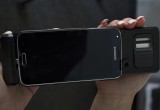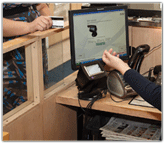Women in Biometric Identity, the 2015 awards: Kimberly A. Mills
Director, Entry/Exit Transformation Office, Office of Field Operations, U.S. Customs and Border Protection
31 December, 2015
category: Biometrics, Government
 Kim Mills was working in the U.S. Visitor Immigrant Status Indicator Technology (US-VISIT) program in 2004 when Congress mandated that the Department of Homeland Security implement a biometric-based entry and exit system.
Kim Mills was working in the U.S. Visitor Immigrant Status Indicator Technology (US-VISIT) program in 2004 when Congress mandated that the Department of Homeland Security implement a biometric-based entry and exit system.
“At the time, I was responsible for the systems that U.S. Customs and Border Patrol (CBP) used on entry, and there wasn’t an exit system. We’d get the manifest data, but there wasn’t really what you’d call an exit system,” Mills says. “I had to develop a way to take the current method used by CBP officers to process travelers arriving in the United States and incorporate biometric verification into that process. That’s basically what led me into biometrics.”
US-VISIT implemented the first portion of the biometric entry process, integrating biometrics into the arrival process for foreign nationals. Over the next few years, this rolled out across all ports of entry – air, land and sea – using ten-fingerprint enrollment. “We’re never going to go away from fingerprints because they add such an enforcement benefit to securing our nation,” Mills says. “But we want to start introducing different biometrics such as face or iris.”
The exit component of the mandate turned out to be more challenging, as field trials failed to yield an easily adaptable biometric exit solution. In 2007, Mills’ work moved to CBP. She was there in 2013 when Congress transitioned the biometric entry/exit operations into CBP, leading to the creation of Mills’ current position as director of the Entry/Exit Transformation Office.
Today she is focused on implementing a biometric exit solution, as well as enhancing the way biometrics are used during entry. “We’re transforming how the entry and exit process is done,” Mills says. “We’re not only looking for a high assurance that the person departed, but it’s an identity verification that you’re not just utilizing somebody else’s travel documents.”
Mills says the current exit system is robust but based on biographic only. Airlines can provide manifests of travelers, but no verification of actual identity. “Now we know your travel document departed, but biometrics can add that high assurance that it really was you that departed as well,” she explains.
Mills counts as her accomplishments:
- The successful integration of biometrics into entry processing. “It has single-handedly has eliminated Visa fraud. You can no longer wash a Visa or fraudulently create a Visa because that document is tied to fingerprints, and when you arrive at the ports of entry, we’re verifying that information,” she says.
- More innovative biometrics such as facial recognition for returning citizens. “We can compare the photograph that’s stored within an electronic passport to a live capture to ensure the person that’s presenting that passport is really the person that the passport was issued to,” says Mills.
- CBP’s implementation of initiatives like handheld biometric devices for data collection at airports. “We’re putting technology in the hands of officers that can actually go out to a departure jet way or passenger loading bridge and conduct a real-time fingerprint verification on a traveler that’s departing the United States,” she says.
Mills says her goals are the successful implementation of a biometric exit solution and a streamlined biometric entry process. “I’d like to see technology tell officers who a person is so that it takes all that administrative processing away from the officer, and we can speed travelers through our ports of entry,” Mills says. “I want to make sure I stay current on what’s next and how I can incorporate that into our operational processes because we’re really trying to take the lead again for biometrics. We did in 2003-2004 when we put fingerprints out there, and now we’re looking to take that lead again in terms of innovation.”
Kim Mills was working in the U.S. Visitor Immigrant Status Indicator Technology (US-VISIT) program in 2004 when Congress mandated that the Department of Homeland Security implement a biometric-based entry and exit system.
“At the time, I was responsible for the systems that U.S. Customs and Border Patrol (CBP) used on entry, and there wasn’t an exit system. We’d get the manifest data, but there wasn’t really what you’d call an exit system,” Mills says. “I had to develop a way to take the current method used by CBP officers to process travelers arriving in the United States and incorporate biometric verification into that process. That’s basically what led me into biometrics.”
US-VISIT implemented the first portion of the biometric entry process, integrating biometrics into the arrival process for foreign nationals. Over the next few years, this rolled out across all ports of entry – air, land and sea – using ten-fingerprint enrollment. “We’re never going to go away from fingerprints because they add such an enforcement benefit to securing our nation,” Mills says. “But we want to start introducing different biometrics such as face or iris.”
The exit component of the mandate turned out to be more challenging, as field trials failed to yield an easily adaptable biometric exit solution. In 2007, Mills’ work moved to CBP. She was there in 2013 when Congress transitioned the biometric entry/exit operations into CBP, leading to the creation of Mills’ current position as director of the Entry/Exit Transformation Office.
Today she is focused on implementing a biometric exit solution, as well as enhancing the way biometrics are used during entry. “We’re transforming how the entry and exit process is done,” Mills says. “We’re not only looking for a high assurance that the person departed, but it’s an identity verification that you’re not just utilizing somebody else’s travel documents.”
Mills says the current exit system is robust but based on biographic only. Airlines can provide manifests of travelers, but no verification of actual identity. “Now we know your travel document departed, but biometrics can add that high assurance that it really was you that departed as well,” she explains.
Mills counts as her accomplishments:
- The successful integration of biometrics into entry processing. “It has single-handedly has eliminated Visa fraud. You can no longer wash a Visa or fraudulently create a Visa because that document is tied to fingerprints, and when you arrive at the ports of entry, we’re verifying that information,” she says.
- More innovative biometrics such as facial recognition for returning citizens. “We can compare the photograph that’s stored within an electronic passport to a live capture to ensure the person that’s presenting that passport is really the person that the passport was issued to,” says Mills.
- CBP’s implementation of initiatives like handheld biometric devices for data collection at airports. “We’re putting technology in the hands of officers that can actually go out to a departure jet way or passenger loading bridge and conduct a real-time fingerprint verification on a traveler that’s departing the United States,” she says.
Mills says her goals are the successful implementation of a biometric exit solution and a streamlined biometric entry process. “I’d like to see technology tell officers who a person is so that it takes all that administrative processing away from the officer, and we can speed travelers through our ports of entry,” Mills says. “I want to make sure I stay current on what’s next and how I can incorporate that into our operational processes because we’re really trying to take the lead again for biometrics. We did in 2003-2004 when we put fingerprints out there, and now we’re looking to take that lead again in terms of innovation.”




